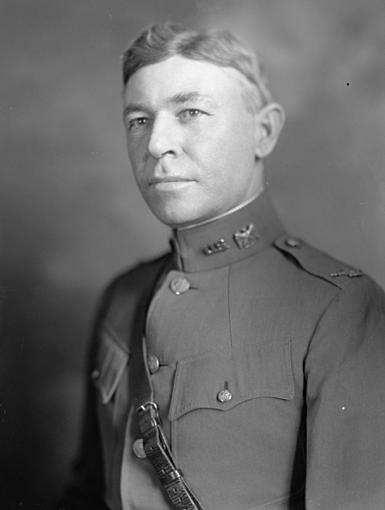

George Franklin Baltzell
Commanding Officer 22nd Infantry
October 1, 1925 - September 1, 1928
and
August 2, 1934 - May 3, 1937
George F. Baltzell was born in
Marianna, Jackson County, Florida on June 13, 1875 and entered
the US Military Academy
on June 21, 1893. He graduated 45 out of a class of 68 on June
11, 1897. His best subjects were Philosophy and
Drill Regulations and his worst subjects were Gunnery and
Drawing.
|
Left: George F.
Baltzell in his class photo Baltzell is in the center facing the camera. Photo from the United States Military Academy |
The following is Baltzell's listing in the USMA Howitzer yearbook of 1897:

Upon graduation Baltzell was commissioned an Additional 2nd Lieutenant in the 12th Infantry on June 11, 1897.
He was on leave from June 11 to
September 30, 1897. On September 30 he reported to the 12th
Infantry at
Fort Niobrara, Nebraska and was assigned to Company D.
On December 16, 1897 he was designated 2nd Lieutenant of the 5th Infantry in Company D.
He left Fort Niobrara and joined
the 5th Infantry at Fort McPherson, Georgia on March 2, 1898.
From April 17
to May 8 he was at Tampa, Florida. From May 8 to July 20 he was
at Fort St. Philip and Port Eads, Louisiana.
From July 20 to August 21 he was at Tampa, Florida preparing for
deployment to Cuba. He landed at Santiago de
Cuba with his Regiment on August 28, 1898 to begin occupation
duty.
On March 2, 1899 Baltzell was promoted to 1st Lieutenant of the 5th Infantry.
He was at: Holguin, Cuba from
April 19 to June 2, 1899; Guantanamo, Cuba from June 2 to
September 21, 1899;
and Palma Soriano, Cuba from September 21, 1899 to January 24,
1900. Baltzell took leave from January 24 to
April 22, 1900 then reported to Fort Sheridan, Illinois where he
remained until August 14. From August 14 to
September 18 he was at San Francisco. He arrived in the
Philippines on October 25, 1900.
His Regiment was stationed on
the Island of Luzon. From October 25, 1900 to June 15, 1901 he
was at Bangued.
From June 15 to September 20, 1901 he was at Bucay. From
September 20, 1901 to January 6, 1902 he was at
Bangued, then he was Dagupan on Lingayen Gulf until July 17,
1902.
Baltzell was promoted to Captain of the 27th Infantry on May 9, 1902.
He was transferred back to the 5th Infantry on August 29, 1902.
(Note: Cullum's Register has no
information listed for Baltzell for the years between 1902 and
1907.
The Army Registers indicate he was in command of Company E 5th
Infantry during that time.)
In 1906 Baltzell graduated from
the Infantry and Cavalry School at Fort Leavenworth, Kansas with
the distinction of
Distinguished Graduate. From August 15, 1907 to August 15, 1908
he attended the Army Staff College at Fort Leavenworth.
Upon graduation from there he was detailed as an instructor in
the Department of Military Art at the Army Service Schools
at Fort Leavenworth, a position he held until July 30, 1911.
From August 1, 1911 to June 15,
1912 he was at Richmond, Virginia as Inspector-instructor of the
Virginia National Guard.
For the next year he was at Plattsburg Barracks, New York
commanding a Company of the 5th Infantry.
On June 3, 1913 Baltzell was
transferred to the 17th Infantry. He reported to Fort McPherson,
Georgia where he commanded
a Company from June 17, 1913 to March 14, 1914. He was at Eagle
Pass, Texas as a Company Commander from March 17
to August 24, 1914. He was transferred to the 10th Infantry on
December 1, 1914. He was with the 10th Infantry at Camp E.S. Otis
in the Panama Canal Zone commanding a Company from December 3,
1914 until May 7, 1915.
On May 2, 1915 he was officially
transferred back to the 5th Infantry. He commanded a Company of
the 5th Infantry at the Camp
at Empire, Canal Zone from May 7, 1915 to May 17, 1916. He was at
Governor's Island, New York from May 25-30. He was then
at Plattsburg Barracks, New York as an Instructor at Training
Camps from June 1 to October 5, 1916.
While at the Training Camps Baltzell was promoted to Major of the 5th Infantry on July 1, 1916.
From October 7 to November 29,
1916 he was at the Headquarters for the Army's Eastern Department
at Governor's Island,
New York as a member of the Board in connection with Regulations
for Training Camps. He was at the Camp at Empire,
Canal Zone commanding a Battalion of the 5th Infantry from
January 22 to August 13, 1917.
He was offerred the temporary
position of Lieutenant Colonel of Field Artillery in the National
Army on August 5, 1917
which he accepted on August 23.
From August 23 to September 4,
1917 Baltzell was at Washington, D.C. as Inspector of the newly
formed 42nd Division
of the National Guard. He was at Camp Mills, Long Island, New
York inspecting the Division from September 5 to
October 17, 1917. He sailed with the Division to France on
November 1, arriving in France on November 8. He was
with the Division at Vaucouleurs, France to November 27. On that
date he went to Chaumont, France where he served
in the Training Section of the General Staff of General
Headquarters, Army Expeditionary Forces. On January 15, 1918
he was officially detailed to the General Staff Army
Expeditionary Forces.
On February 6, 1918 he was promoted to the temporary rank of Colonel of Infantry.
He remained at Chaumont until
June 15, 1918 and then went to Langres, France as a student
officer at the Army General
Staff College there. He was honorably discharged from his rank of
Lieutenant Colonel of Field Artillery in the National Army
on March 27, 1918. He finished the course at the General Staff
College on July 31, 1918 and then was stationed at Neufchâteau,
France as Chief of Operations Section, General Staff, G-3 6th
Army Corps. He continued in this position moving to: Bourbonne-
les-Bains, France on August 13; Belfort, France on August 28; and
Saizerais, France from September 11 to December 2, 1918.
Baltzell returned to Chaumont,
France where he again served in the Training Section of the
General Staff of General Headquarters,
Army Expeditionary Forces from December 28, 1918 to February 13,
1919, on which date he sailed from France enroute to the
United States arriving there on February 24.
He was at Washington, D.C. in
the Training and Instruction Branch, War Plans Division, General
Staff from February 27 to
September 20, 1919. On September 21 he went to Fort Benning,
Georgia where he became the Executive Officer of the
Infantry School.
Baltzell's temporary promotions ended and he was returned to his permanent rank of Major on February 11, 1920.
He was promoted to Colonel of
Infantry in the Regular Army on July 1, 1920, never having
attained the permanent rank
of Lieutenant Colonel.
He left the Infantry School on
July 20, 1920. From August 10, 1920 to September 14, 1921 he
served in the newly created
Office of the Chief of Infantry at Washington, D.C. He reported
as a student officer at the Army War College in Washington,
D.C. on September 15, 1921, graduating from there on June 30,
1922. He served in the Office of the Chief of the Militia Bureau
from August 22, 1922 to July 1, 1925. (The Army Registers show
his detail to the Militia Bureau as August 31, 1922 to July 1,
1925.)
Baltzell officially assumed command of the 22nd Infantry on October 1, 1925.
From October 1 to December 6,
1925 he was a student officer at the Infantry School at Fort
Benning, Georgia, attending a
Refresher Class for Field Grade Officers. Upon finishing the
class Baltzell commanded the 22nd Infantry at Fort McPherson,
Georgia from December 7, 1925 to September 1, 1928.
From September 4, 1928 to July
31, 1930 he was at Jacksonville, Florida as Instructor-inspector
of Florida involving the
Reserve Corps Camps and the Citizens' Military Training Camps
(C.M.T.C.) He was at Fort Benning, Georgia as
Director of the Infantry Board from August 1, 1930 to August 1,
1934.
On August 2, 1934 Baltzell was at Camp McClellan, Alabama commanding the 22nd Infantry.
He was at Fort Benning, Georgia
on temporary duty commanding District D of the Civilian
Conservation Corps (CCC)
from May 22 to June 30, 1936.
On May 3, 1937 he relinquished
command of the 22nd Infantry and was ordered home to await his
retirement.
He was due to retire on August 31, 1937 but died at his home at
Marianna, Florida on August 6, 1937.
|
Colonel George F. Baltzell as Commanding Officer 22nd Infantry at Camp McClellan, Alabama 1926. Photo from The Cimitracam The yearbook of the CMTC training
program webmaster's collection |
GEORGE FRANKLIN BALTZELL
NO. 3786 CLASS OF 1897
Died August 6, 1937, at Marianna, Florida, aged 62 years.
FRANKLIN BALTZELL was born in
Marianna, Florida, June 13, 1875. His youth was spent in
attendance at the schools
of his native town, where his studiousness, goodness, modesty,
and love of outdoor life made of him a great favorite with all.
The friends of his youth included all who knew him, the young and
the aged, the well-circumstanced and the less fortunate,
the whites and negroes. Their numbers were legion, and their
steadfast devotion to him through life was equalled only by his
loyalty to them. At the age of eighteen he received an
appointment to the United States Military Academy, West Point,
New York, and was admitted as a cadet June 21, 1893.
While at West Point his modesty
and correct conduct endeared him to his classmates
whose personal devotion to him in later years never wavered.
He graduated June 11, 1897, and
was assigned to the Infantry. He was on graduation leave of
absence from June 11, 1897,
to September 30, 1897, when he reported for duty as an additional
Second Lieutenant to the 12th Infantry at Fort Niobrara,
Nebraska. He was promoted 2d Lieutenant, 5th Infantry, December
16, 1897, but remained on duty with the 12th Infantry
until March 2, 1898.
He joined the 5th Infantry March
7, 1898, at Fort McPherson, Georgia, and served with that
regiment at that post until
April 17, 1898; at Tampa, Florida, to May 8, 1898; at Fort St.
Philip and Port Eads, Louisiana, to July 20, 1898, and again
at Tampa, Florida, to August 21, 1898. He sailed for Cuba with
the 5th Infantry, August 21, 1898, and served at Santiago,
Cuba, until April 19, 1899; at Holquin, Cuba, to June 7, 1899;
Guantanamo, from June 12, 1899, to September 30, 1899,
when he returned to Santiago. On October 17, 1899, he changed
stations to Palma Soriano and on January 18, 1900,
to San Luis. He was en route to the United States from January 24
to 29, 1900, and on leave of absence to April 19, 1900.
He rejoined his regiment April
21, 1900, at Fort Sheridan, Illinois, and on August 20, 1900,
left that station en route to
the Philippine Islands. He sailed from San Francisco, California,
September 18, 1900, and arrived at Manila, P. I.,
October 25, 1900. He served with the regiment, in the Philippine
Insurrection, being stationed at Bantay, Bucan, and Bangued.
He was in command of the mounted detachment when it was attacked
on the road between Tayum and Bucay,
February 2, 1901, and again, near the same place, on February 8,
1901. He was in command (temporary) of Company "C",
Native Scouts, at La Paz, and Bangued from April to June 1901,
and in temporary command of Company "I",
at La Paz, July-October, 1901.
On July 17, 1902, he sailed from
the Philippine Islands, arriving in the United States September
6, 1902, and availing himself
of leave of absence. He was on temporary duty with the 16th
Infantry at Fort McPherson, Georgia, from September 6, 1902,
to July 9, 1903, when he departed for Plattsburg Barracks to
await the arrival of his regiment at that post. He rejoined the
5th Infantry, at Plattsburg Barracks, July 24, 1903, and served
with it at that station to August 15, 1905. He then attended
the Infantry and Cavalry School at Fort Leavenworth, Kansas,
graduating August 15, 1906. He was on duty at the
Army Staff College to October 1, 1906.
He sailed from the United States
October 2, 1906, and served with the 5th Infantry, with the Army
of Cuban Pacification,
from October 11, 1906, to July 17, 1907. He arrived in the United
States July 28, 1907, and returned to the Army Staff College,
Fort Leavenworth, Kansas, for duty as a student. He was graduated
therefrom on August 15, 1908, and immediately entered
on duty as an Instructor, Department of Military Art, at the Army
Service Schools, Fort Leavenworth, Kansas. He was relieved
from the latter duty on July 30, 1911, and assigned duty as
Inspector-Instructor, National Guard of Virginia, with station
at Richmond. He was relieved from this duty June 15, 1912. He
rejoined his regiment and served with it at Plattsburg Barracks
until June 15, 1913. He served with the 17th Infantry at Fort
McPherson, Georgia, from June 17, 1913, to March 14, 1914;
(transferred to the 17th Infantry on June 3, 1913)—en route
to the Mexican Border to March 19, 1914, and on Border Patrol
at Eagle Pass, Texas, to August 24, 1914, when he departed on
leave of absence,
upon the termination of which he sailed for the Canal Zone.
On December 1, 1914, he was
assigned to the 10th Infantry and served with that regiment at
Camp E. S. Otis, Canal Zone,
from December 4, 1914, to May 11, 1915, when he reported for duty
with the 5th Infantry (transferred to the 5th Infantry
May 2, 1915) at Empire, Canal Zone, to August 12, 1917, except
while on detached service in the United States from
May 13, 1916, to January 15, 1917. While on detached service in
the United States he was on duty as instructor at the
Officers Training Camp, Plattsburg Barracks, New York, from May
14 to October 5, 1916, and was a member of
a Board of Officers in connection with regulation for training
camps from October 6, 1916, to November 28, 1916.
He was en route from the Canal Zone to the United States from
August 13 to August 22, 1917.
Colonel Baltzell became
Inspector, 42nd Division, on August 24, 1917, and served in that
capacity until November 25, 1917.
During this period he was stationed at Washington, D. C., to
September 4, 1917; at Camp Mills, New York, to October 19, 1917;
sailed for Europe October 19, 1917; arrived France November 1,
1917, and with the Division at Vaucouleure, France, to
November 25, 1917.
He was on duty with the Training
Section, G-5, General Staff, General Headquarters, American
Expeditionary Forces,
Chaumont, France, from November 28, 1917, to (on January 21,
1918, he was detailed as an Acting General Staff Officer
and announced as a Member of the General Staff, A. E. F.) June
15, 1918. He attended the General Staff College, Langres,
France, from June 20 to July 31, 1918. He was then assigned duty
as Chief, Operations Section, General Staff,
VI Army Corps, serving in that capacity until (Acting Chief of
Staff, VI Army Corps, October 17, 1918 to October 21, 1918)
January 7, 1919. He was with the Training Section, G-5, General
Headquarters, from January, 1919, to February 12, 1919,
when he was directed to proceed to the United States to present
to the Chief of Staff plans for the revision of the
military education system of the United States Army. He left
Chaumont, France, February 13, 1919, and sailed for the
United States on February 17, 1919. Upon his arrival in the
United States on February 24, 1919, he proceeded to
Washington to serve with the Training Branch, War Plans Division,
War Department General Staff from February 28, 1919,
to August 15, 1919. He was then on duty at the General Staff
College, Washington, to September 4, 1919.
On temporary duty in the War Department General Staff to
September 18, 1919.
On September 21, 1919, he became
Executive Officer, The Infantry School, Fort Benning, Georgia, in
which capacity
he served until July 20, 1920, when he departed on leave upon the
termination of which on August 14, 1920,
he became Chief, Personnel Section, Office of the Chief of
Infantry, Washington.
|
Left: Article announcing the creation
of INFANTRY JOURNAL Volume XVII |
He attended the Army War College
from August 15, 1921 to July 1, 1922, when he was graduated and
departed on leave.
He was Chief of the Training Section, Militia Bureau, from August
31, 1922, to July 1, 1925; on leave to September 30, 1925;
and was a student, Refresher Course, The Infantry School, Fort
Benning, Georgia, to December 5, 1925.
Baltzell commanded the 22nd
Infantry from October 1, 1925 to September 1, 1928. During this
period he was also
in command of the Citizens Military Training Camps, Camp
McClellan, Alabama, from June 1, 1926, to August 10, 1926;
and on temporary duty as Assistant Officer in charge of National
Guard Affairs, Headquarters, 4th Corps Area,
from October 30, 1926, to December 24, 1926.
He was Inspector-Instructor of
the Organized Reserves, State of Florida, from September 4, 1928,
to July 31, 1930,
being also Chief of Staff, 82d Division Reserves, Jacksonville,
Florida, from March 1, 1929, to June 30, 1929.
He was Director of the Infantry Board, Fort Benning, Georgia,
from August 1, 1930, to August 1, 1934.
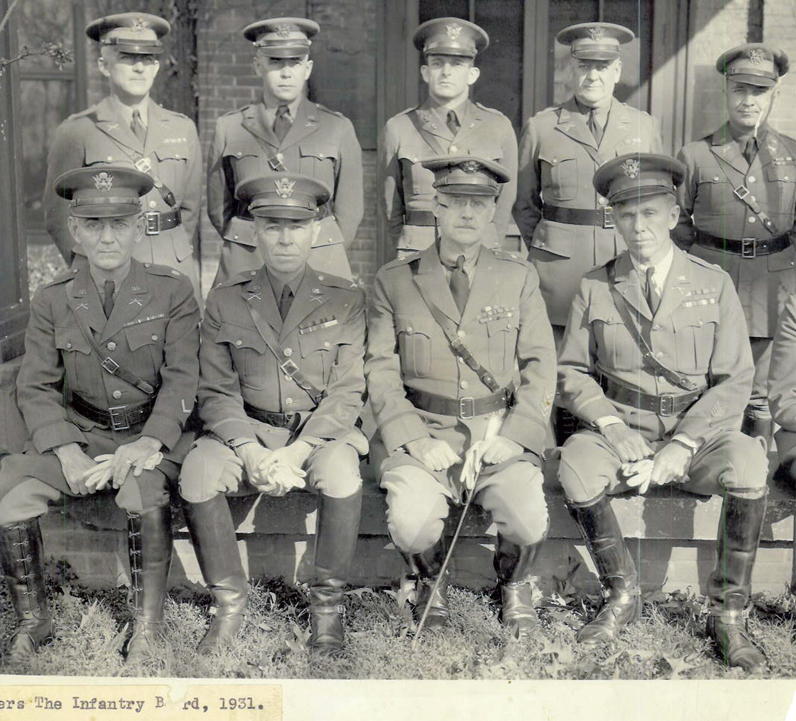
Members of the Infantry
Board, Fort Benning, Georgia, 1931.
Colonel George F. Baltzell, Director of the Board, is seated,
second from left.
Also seated, far right, is Lieutenant Colonel George C. Marshall,
who would go on to become one of only five 5-star Generals in
Army history.
Photo from the Fort Benning Photostream on Flickr
Colonel Baltzell was again
assigned to the 22nd Infantry and was in command of that regiment
at Fort McClellan, Alabama,
from August 1, 1934, to May 3, 1937. During this period he was
also in command of District "D", Civilian Conservation
Corps,
and was on temporary duty with his regiment at Fort Benning,
Georgia from May 22, 1936
to June 30, 1936.
Colonel Baltzell's retirement
had been ordered effective August 31, 1937 and he was awaiting
retirement at his home,
Marianna, Florida at the time of his death.
He was awarded the Distinguished Service Medal:
"For exceptional
meritorious and distinguished services as Inspector, 42nd
Division, G-5, General Headquarters,
American Expeditionary Forces and G-3, 6th Army Corps. While
serving as G-5, General Headquarters, A. E. F.,
Colonel Baltzell was charged with the supervision of the Army
Schools, training inspections of troops and the
preparation of studies on military education. In all of these
positions of great responsibility Colonel Baltzell displayed
professional attainments of a high order, untiring energy and
devotion to duty and contributed to a very great degree
to the satisfactory training of officers and troops of the
American Expeditionary Forces and to the development of
the present system of military schools in the United
States."
The President of the French
Republic conferred upon Colonel Baltzell the decoration of
Officer of the Order of the Black Star. (September 24, 1919).
Colonel Baltzell was a member of
the Society of the Cincinnati and of the
Florida Society of the Sons of the American Revolution.
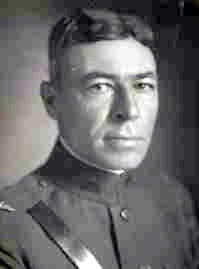
Colonel George F. Baltzell
The Baltzell family came to
America from Alsace, Germany, and settled in Frederick, Maryland,
in 1735.
His grandfather, Dr. George Franklin Baltzell, entered West Point
from Kentucky in 1824 but did not graduate.
He later became a practicing physician and moved from Frankfort,
Kentucky, to Marianna, Florida, in 1830.
His father was George Albert
Baltzell, publisher and planter of Marianna, Florida.
His mother was Rachel Robenson of Albany, Georgia.
While stationed at Plattsburg
Barracks, New York, he was married to Lucile Atkinson, daughter
of William Yates Atkinson
(former Governor of Georgia) and Susan Cobb Milton Atkinson, on
November 11, 1903, at Newman, Georgia. To this union
was born one son, George Franklin Baltzell, Jr., on October 1,
1904, at Plattsburg Barracks, New York, who graduated
in the Class of 1929 from the United States Military Academy, and
died March 18, 1932, at Fort Screven, Georgia,
at the age of twenty-seven years. Father and son rest side by
side in beautiful Arlington.
Colonel Baltzell is survived by
his widow, Lucile Atkinson Baltzell, his brother Dr. Nicholas
Albert Baltzell, and his sister,
Mrs. A. B. MacKinnon, all of Marianna, Florida.
My knowledge of his beautiful
and inspiring character was planted in esteem's deep fixed soil.
Our friendship, through
the constant culture of kind intercourse, was brought to
perfection. His inward traits were known to me only as a
lieutenant learns to know his frank, considerate, and talented
captain.
His most outstanding personal
attributes included gentleness of manner, sweetness of
disposition, magnetic presence,
superior mentality, and absolute loyalty. The prosperity of his
friends and their happiness was more dear to him than his own.
Those of us privileged to serve
under him were indeed fortunate. The lessons we learned were not
restricted to
routine administration and tactical doctrines. They included
examples of loyalty, patriotism, sense of duty, honor and
chivalry.
No one knew better than he that there is much that is vital to
our profession that cannot be learned from books and the lecture
platform.
Those of us who knew him well
shall always contemplate his tireless spirit, stout heart,
devotion to duty, chivalrous
and generous nature with the deepest stirrings of affection and
admiration.
He served his community, state, and country with zealous devotion and lofty patriotism.
He left a record that will live among the honored names of his alma mater and the American Army's annals.
I have never known a man that I loved more nor an officer that I admired more—in truth I am thankful for every remembrance of him.
Asa L. Singleton,
Brigadier General, U. S. Army. ¹
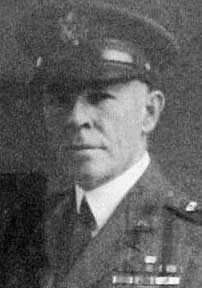
This portrait of Colonel Baltzell hung
on the wall at 1st Battalion 22nd Infantry Headquarters
at Fort Hood, Texas, 1999-2009, though his name was incorrectly
spelled as "Buttzel".
The photo was taken during his Command of the 22nd Infantry. Note
the 22nd Infantry DUI on his shoulder strap.
Photo courtesy of Major Anne LeGare, wife of LTC Marc LeGare,
Commanding Officer 1-22 IN 1999-2001.
The citation for the award of the
Distinguished Service Medal to George F. Baltzell:
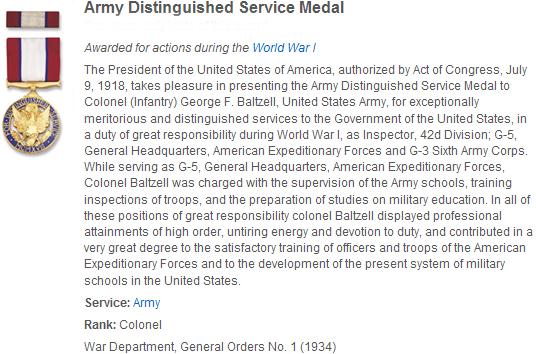
Illustration from the Military Times Hall of Valor
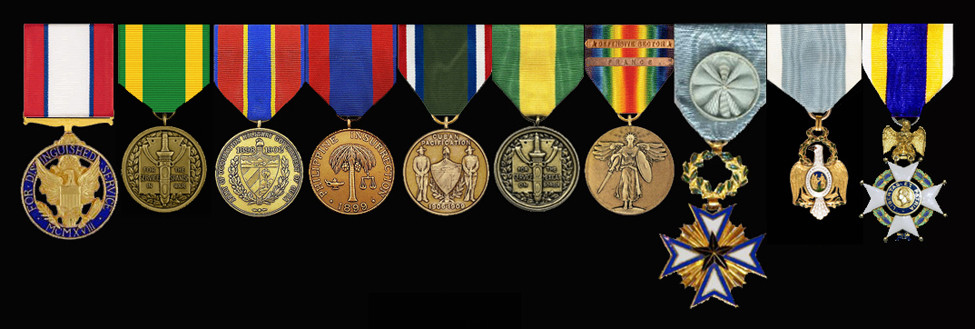
George F. Baltzell's decorations
The following is an article from the The Anniston Star
with comments added by the website editor
Col. George F. Baltzell.
It takes a sterling career to
have a road named after you.
Col. George F. Baltzell — of Baltzell Gate fame — was a
decorated officer of the Army
who helped to develop the military school system.
Baltzell was born in 1875 in Marianna, Fla., and died there at
age 62.
He was a career military man, who after many other posts spent
his final assignment
in command of the 22nd Infantry at Fort McClellan.
After his 1897 graduation from the U.S. Military Academy,
Baltzell served in Cuba during the Spanish-American War.
He then sailed for a tour in the Philippines before attending the
Infantry-Cavalry school where he was a distinguished graduate.
Baltzell graduated the Army Staff College at Fort Leavenworth,
Kan., then stayed for several years
teaching military art in the Army Service Schools.
In 1911 he was ordered to the Panama Canal as
Inspector-Instructor of the Virginia National Guard for six
years.
During WWI he was named Inspector of a National Guard division
from Washington D.C. and was shipped to France.
Less than a month after he arrived, he was moved to the training
staff, where he served for the next year.
He returned to the United States
in February 1919 and served as the executive officer of the
Infantry School
at Fort Benning, Ga., for about a year before returning to
Washington, working in the office of the Chief of Infantry.
Baltzell received the Distinguished Service Cross (Website Ed.,
should read: Distinguished Service Medal)
for contributing to the training of officers and troops of the A.
E. F. and to the development of military school system.
After graduating the Army War College in 1922, he was assigned to
work in the office
of the chief of militia bureau for three years.
He then left and took a short course at the infantry school
before being put in charge of the 22nd Infantry.
Baltzell was then moved in that capacity, to Fort McClellan where
he served out his final assignment.
Baltzell's finale
by Nick Cenegy
Staff WriterAug 03, 2008
The Anniston Star
**********************
Burial:
Arlington National Cemetery
Arlington
Arlington County
Virginia, USA
Plot: Section 1 Site 488-1
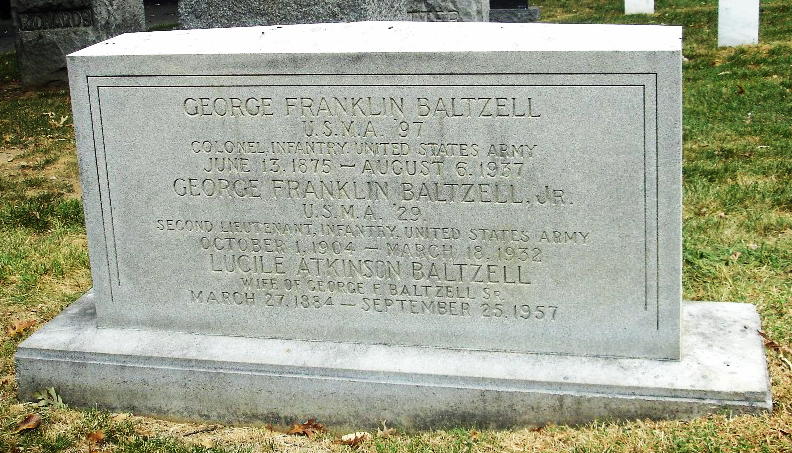
The grave monument for George F.
Baltzell
Note that his son, also a graduate of the US Military Academy,
died before him and is buried with him.
Photo by Hope from the Find A Grave website
|
George Franklin Baltzell Jr. Son of Colonel George F.
Baltzell, Vice President of his
graduating class, |
¹ SIXTY-NINTH ANNUAL REPORT of the Association
of Graduates of the United States Military Academy
at West Point, New York June 13, 1938, The Moore Printing
Company, Inc., Newburg, New York
Additional Sources:
Official Army Registers 1897-1937
Adjutant General's Office
Returns of the 22nd Infantry
BIOGRAPHICAL REGISTER of the OFFICERS AND
GRADUATES of the U.S. MILITARY ACADEMY
at West Point, New York, Since Its Establishment in 1802 by
Brevet-Major-General George W. Cullum
Supplement VOL. IV 1901, Supplement VOL. V 1910, Supplement VOL.
VI-A 1920,
Supplement VOL. VII 1930-1940
Home | Photos | Battles & History | Current |
Rosters & Reports | Medal of Honor | Killed
in Action |
Personnel Locator | Commanders | Station
List | Campaigns |
Honors | Insignia & Memorabilia | 4-42
Artillery | Taps |
What's New | Editorial | Links |